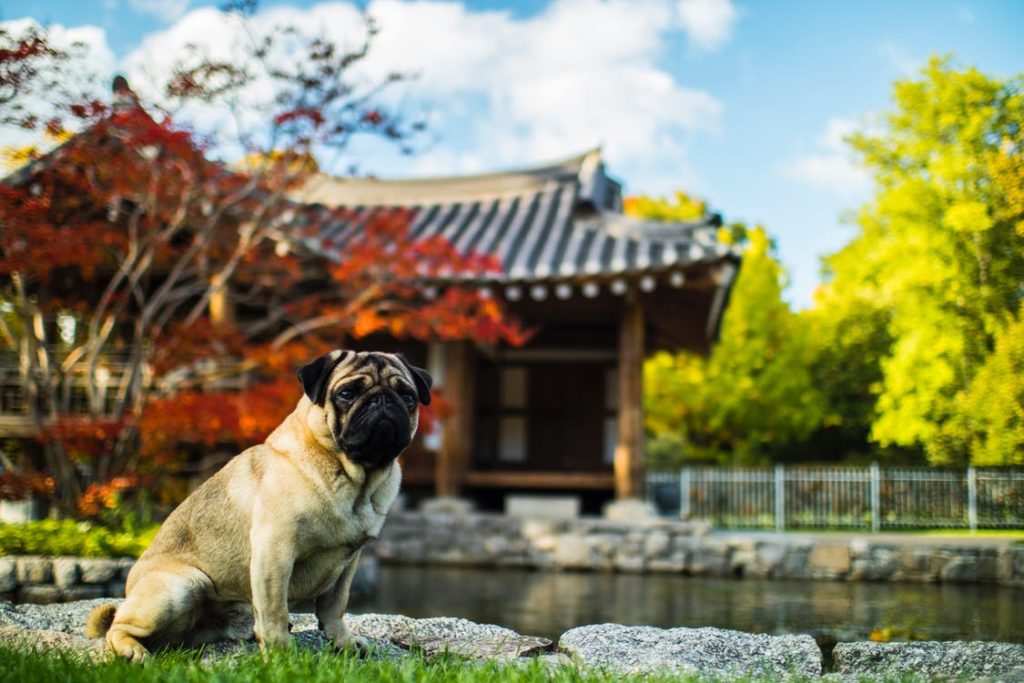Pug Stats:
Classification: Toy, Companion Group
Weight: 13-20lbs.
Height: 12-14 inches, 30-36cm at the withers (shoulders)
Lifespan: 12-15 years
Pug Breed History

The Pug originated in Eastern China to lay in the laps of Chinese royalty during the Shang dynasty in 400BC. The dogs exact origin is unknown as Emperor Qin Shi Huang destroyed all records of the Pug during his reign between 221-210 BC.
The Pugs popularity continued however, and soon reached Tibet where they were kept by monks, the dogs popularity continued to Japan and on to Europe. The breed found its way to the House of Orange , where a Pug saved the Prince of Orange’s life by barking to scare off a potential assassin. William III and Mary II travelled with a Pug when they took over the English throne in 1688.
Pugs were incorporated into paintings in Spain and rode with the coachmen of the rich in Italy, dressed up in matching attire. They were used by the military to track other animals and people, and were also used as guard dogs.
During the 1800’s Queen Victoria began to breed Pugs herself. Her love and devotion to the breed helped establish the Kennel Club in 1873. Also, in the 19th century the United States of America saw the Pug for the first time. By 1885 the Pug was accepted in the American Kennel Club.

Pug Traits
The pug is often described as a dog that has “much in little” referring to its gentle, friendly personality and strong, but square and small body frame. These dogs are known to be fond of children, quiet and docile. They are often aware of their owners emotions and can be very playful and bratty at times. The Pug is valued for its ability to be alert, but does not bark often. Pug puppies are known as “Puglets”. Puglets do best in families that can play with them indoors and outdoors on a daily basis and who have the patience and consistency to properly train a Pug puppy from day one.
Pug Health Problems
Of course, most Pugs will be perfectly healthy, these are just the specific health risks that more commonly affect this breed. It is important to know what health risks are specific to the breed you choose so you can better prepare and care for them if the unthinkable should occur. Some risks are easily treatable while other conditions may occur more in the aging dog and become chronic conditions with no cure, but are controlled by symptomatic management.
The most common health issues with Pugs include eye injuries, heat intolerance, respiratory issues, obesity, skin infections within the facial skin folds, less common and life threatening is a condition called glaucomatous menigoencephalitis an inflammation of the central nervous system. Hemivertebrea, a painful condition where a spot in the dog’s spinal cord fuses and causes a torsion like the “spin” in the tail, and causes the dog a lot of pain and disability. Unfortunately, some of these health problems are a result of over breeding.
However, when you do your research and choose a reliable breeder your dog should have a health guarantee, which includes early vet checks, and vaccines. If you chose to adopt from a rescue or shelter, make arrangement for a vet check and consider potential health costs at present and in future, as less in usually known about rescue and sheltered dog health history.

A Pug Brings Family Fun
A Pug is a wonderful addition to a family with children of all ages. This fun-loving dog breed is often adored for it’s “cute” appearance as the dog maintains a puppy-like look even at older ages due to multiple skin folds. The breed originated in Eastern China during the Shang Dynasty and eventually became popular through Spain and Europe. Owned by Queen Victoria in Canada during the 1800’s, her work with breeding Pugs played a major role in initiating the Kennel Club, and influencing the United States.
Often though of as “much in a little” package, pugs are gentle dogs that love their family pack. They can be prone to some health issues, especially breathing issues because of their very short snout. They cannot handle high temperatures for long periods of time. However, anyone who has ever owned a Pug, only sees the love and fun that these great dogs bring to a family.

